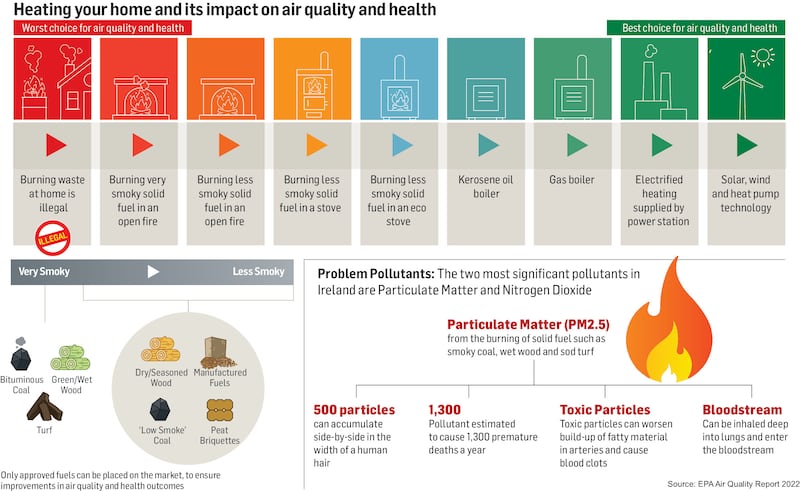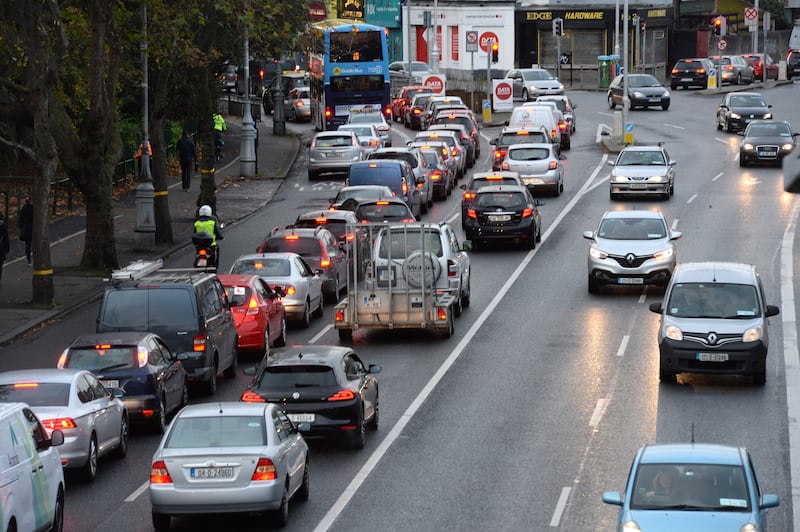Only now is the deadly effect of fine particle air pollution, particularly in Irish cities, being understood.
The latest indications of air pollution are “pretty stark” and show science is catching up in revealing the extent of the problem, says Mark Murphy of the Irish Heart Foundation).
The data points to the vulnerability of people living in urban areas, especially Dublin, where air pollution occurs at a higher level due to a combination of burning of solid fuels and heavy traffic.
Evidence is growing of damaging effects from pollutant PM2.5 – the fine particulate matter created mainly from burning fuel in homes – and especially its notorious ability to enter the bloodstream and affect all organs in the body, says Murphy, who is the foundation’s advocacy manager for environmental health.
RM Block
The latest Environmental Protection Agency air quality report, for 2022, found these tiny dust particles were the biggest air pollution threat in Ireland. That is also the case in relation to cardiovascular health, including stroke, says Murphy. The EPA says PM2.5 is responsible for the vast majority of premature deaths in Ireland caused by air pollution.
[ What is PM2.5? Only the biggest air pollution threat to human health in IrelandOpens in new window ]
In cold, calm days of winter the capital often experiences PM2.5 levels considerably greater than the World Health Organisation guideline of 5 microgrammes per cubic metre (µg/M3), the measure that gauges the concentration of an air pollutant.
A Guardian investigation has found only 2 per cent of the population of Europe live in areas within this limit. Experts say PM2.5 pollution causes about 400,000 deaths a year across the continent. It found Ireland’s PM2.5 problem was concentrated along the east coast, with Dublin faring worst with levels at 8.5-10 µg/m3; and Cork, Limerick and Waterford having levels of 7.5-8.5 µg/m3, all exceeding WHO guidelines.
A study by the Irish Heart Foundation and British Heart Foundation Northern Ireland found there were 1,682 attributable deaths a year in the Republic due to PM2.5 air pollution, of which 681 were due to circulatory disease (based on 2019 data) – more than 10 times the number of people killed on Irish roads in 2022. Associated health costs come to €2.3 billion a year.

“Although other risk factors such as hypertension and smoking are far more important risk factors, air pollution significantly increases risk of CVD [cardiovascular disease] especially in those people with other risk factors and the elderly,” says consultant cardiologist Dr Angie Brown, the Irish Heart Foundation’s medical director.
“Worsening levels of air pollution, particularly PM2.5 is linked to higher levels of heart disease and stroke, as well as increased premature deaths ... if the Republic of Ireland met WHO guideline levels, over 560 lives would be saved and almost 1,000 lives would be saved on the island of Ireland.”
Research in 2020 showed winter air pollution is associated with more hospitalisations for all strokes in Dublin, she says.
“During winter months in Ireland, particularly in Dublin, higher levels of fine particles, coarse particles, sulphur dioxide and nitrogen dioxide are found in the air. The sources of these are solid fuel burning, such as coal, peat, and wood, as well as road traffic – especially diesel engines.”
Dr Brown underlines the need to raise awareness of air pollution risks and advocate for “heart-healthy cities” with a sustainable architecture and environment. Moving away quickly from burning solid fuels such as sod turf, wood, smoky and smokeless coal would be the single most effective action.

“Solid fuels are the largest contributor to PM2.5 in Ireland and thus if we transition to cleaner, healthier forms of home heating, such as electricity or heat pumps, it would deliver the greatest health benefit,” says Brown.
Although Ireland had did not exceed legally binding EU limits last year and air quality was generally good, this does not mean the country is in a perfect place, says HSE public health consultant Dr Keith Ian Quintyne.
EPA data and Guardian modelling highlights WHO limits should ideally be in place, he adds, and serve as a wake-up call requiring a multidimensional response.
At a personal level, there should be no burning of solid fuels, more active travel (walking and cycling), increased public transport and less car use. At policy level, there was a need to increase engagement on the consequences of burning solid fuels.
It is not just about the mortalities ... It is also about the impact on health and wellbeing. We have some very stark figures in Ireland where asthma rates are among the highest in Europe
— Green TD Marc Ó Cathasaigh
On whether air pollution is leading to increased cases of respiratory illness, cardiovascular disease and other conditions, he says it is hard to give a definitive answer, but when pollutant levels rise there are increased hospital admissions in Dublin with acute asthma, cardiovascular disease and neurological conditions in following days.
“That is clear and demonstrable. We can’t say it’s getting worse,” says Quintyne.
The vulnerability of people living in the Greater Dublin Area has a lot to do with higher population density compared with other parts of the country. He contributed to a 2020 study that found reduced traffic during the Covid-19 pandemic led to reduced admissions for respiratory related conditions.
“When we move around less or are in the car less, there is less air pollution,” he adds, which brings tangible health benefits.
A study he carried out with the EPA shows the public had good knowledge about air pollution but lack understanding of what they could do to counteract it.
Even if air pollution does not kill someone, it can still seriously impact their health, as the latest evidence indicates. “There is no safe level of air pollution,” says Murphy. As for chief culprit PM2.5, he believes the sooner sustainable transport systems, including Bus Connects, are introduced backed by increased active travel, the quicker immediate health benefits will be realised.
Green TD Marc Ó Cathasaigh highlighted the wide pollution impact in the Dáil this week: “It is not just about the mortalities ... It is also about the impact on health and wellbeing. We have some very stark figures in Ireland where asthma rates are among the highest in Europe.
“There are 8,000 asthma admissions to hospital each year, and 2.4 million asthma GP consultations each year. Every four minutes someone in Ireland visits an emergency department with asthma. Every six days one person in Ireland dies of asthma.
“Polluted air increases the risk for people with cancer, diabetes, cognitive impairment and dementia. Even low birth rate can be associated with it. The evidence for this is robust and getting stronger,” says the Green Party TD.
Ireland is committed to fully adopting WHO guidelines by 2040.
[ Five ways to protect yourself from indoor and outdoor air pollutionOpens in new window ]
However, says Minister of State Josepha Madigan, “our ambition to move to the WHO guidelines levels means newer targets will be extremely difficult to achieve so long as petrol- and diesel-fuelled vehicles remain in widespread use, particularly in urban areas”.
There is a move from recording air quality to forecasting through the EPA’s Life Emerald project. This uses its monitoring network to provide near-real-time mapping of pollutants and provide a national three-day air quality forecast and better inform the public in minimising their exposure.
A prototype app in development at Insight SFI Research Centre for Data Analytics at Dublin City University could offer pedestrians and cyclists a significant reduction in pollution exposure.
Refining and supplementing the publicly available Google air quality data set for Dublin, a team led by Dr Mingming Liu is building a database capable of suggesting green travel routes for those travelling the city. Users are shown their quickest, and least polluted, routes on an interactive map.
“Promoting active transportation modes such as walking and cycling over fossil-fuelled vehicles is critical in encouraging people to move towards greener transportation options,” says Liu.
“However, at present, active transportation users such as walkers, runners and cyclists have very limited awareness of the pollution levels in their surroundings, making them susceptible to various health risks while walking or cycling on the roads.”

















